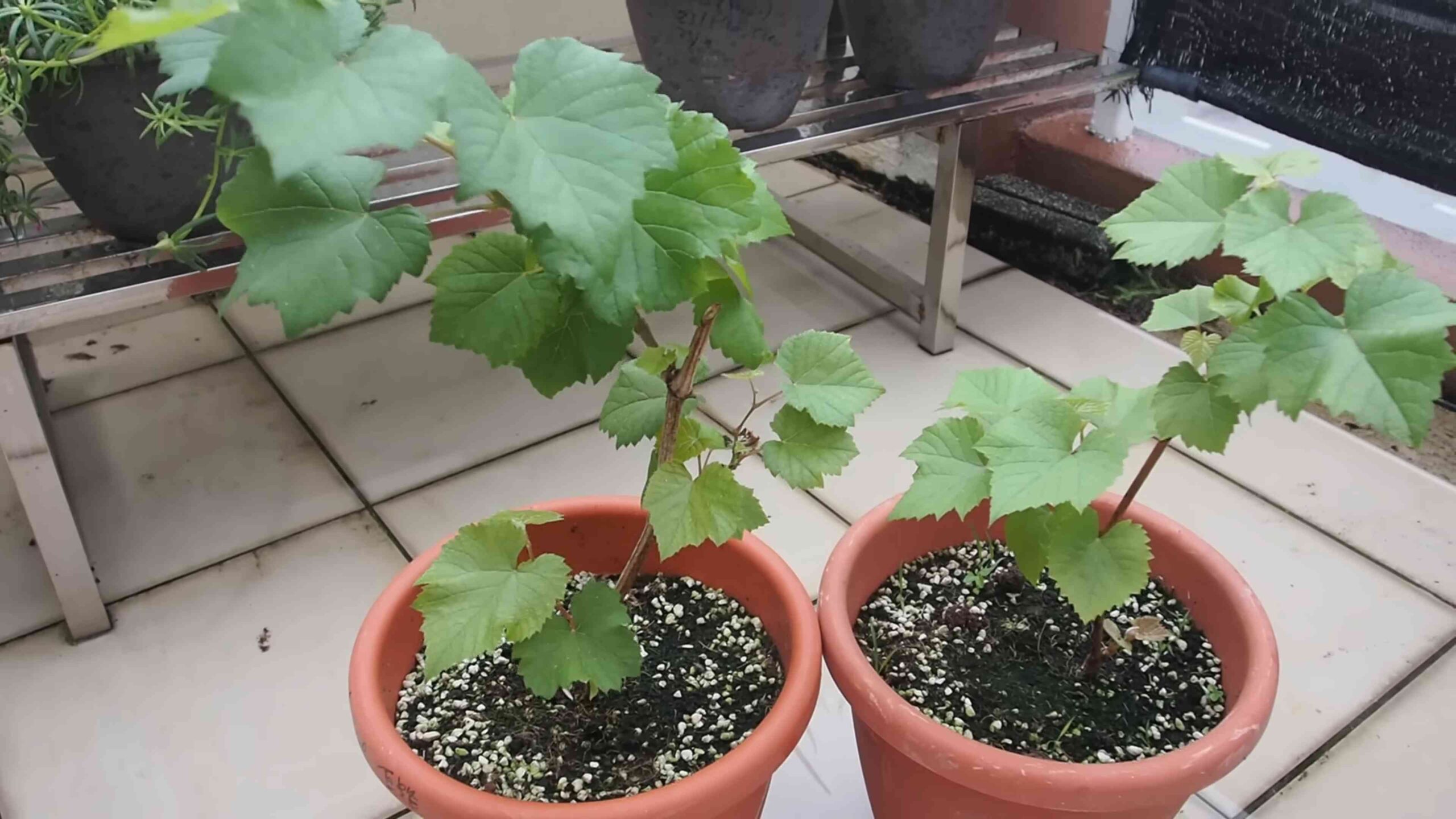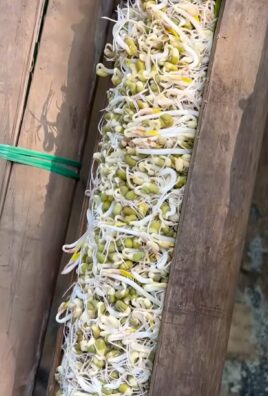Growing Grapevines in Your Garden might seem like a task reserved for seasoned vintners in sun-drenched vineyards, but I’m here to tell you that cultivating your own grapes is surprisingly achievable, even in your backyard! Imagine plucking juicy, sun-ripened grapes straight from the vine, ready to be enjoyed as a snack, transformed into homemade jam, or even fermented into your own signature wine. Sounds dreamy, right?
Grapevines have a rich history, dating back thousands of years to ancient civilizations like the Egyptians and Romans, who revered them for their fruit and the intoxicating beverage they produced. Today, the allure of growing your own food, connecting with nature, and enjoying the fruits (pun intended!) of your labor is stronger than ever.
But why should you consider growing grapevines in your garden? Beyond the delicious harvest, grapevines offer beautiful foliage, providing shade and adding a touch of rustic charm to your landscape. Plus, learning how to properly prune and care for your vines is a rewarding experience that connects you to the age-old tradition of viticulture. In this article, I’ll share my favorite DIY tricks and hacks to help you successfully cultivate thriving grapevines, regardless of your gardening experience. Get ready to embark on a grape-growing adventure!

Growing Grapevines in Your Garden: A DIY Guide
Hey there, fellow gardening enthusiasts! I’m so excited to share my experience and guide you through the rewarding process of growing your own grapevines. Imagine plucking fresh, juicy grapes right from your backyard – it’s totally achievable with a little patience and know-how. Let’s dive in!
Choosing the Right Grape Variety
Before you even think about digging, you need to pick the perfect grape variety for your climate and taste. This is super important!
* Consider your climate: Some grape varieties thrive in warm climates, while others are more cold-hardy. Check your USDA plant hardiness zone to make sure the variety you choose is suitable.
* Think about your taste preferences: Do you prefer sweet table grapes, tart wine grapes, or something in between? Research different varieties and read reviews to find one that appeals to you.
* Disease resistance is key: Look for varieties that are resistant to common grape diseases like powdery mildew and black rot. This will save you a lot of headaches (and fungicide!).
* Space matters: Grapevines can get quite large, so consider the amount of space you have available. Some varieties are more compact than others.
Some popular and relatively easy-to-grow varieties include:
* ‘Concord’: A classic American grape, known for its distinctive flavor and hardiness. Great for juice, jelly, and eating fresh.
* ‘Thompson Seedless’: The most popular seedless table grape, perfect for snacking. Requires a warm climate.
* ‘Niagara’: A white grape with a sweet, musky flavor. Good for juice, wine, and eating fresh.
* ‘Reliance’: A pink seedless grape that is very cold-hardy.
Preparing the Planting Site
Okay, you’ve chosen your grape variety – awesome! Now it’s time to get the planting site ready. This is where the magic begins!
* Sunlight is essential: Grapevines need at least 6-8 hours of direct sunlight per day. Choose a location that gets plenty of sun.
* Well-drained soil is a must: Grapevines hate soggy roots. Make sure the soil drains well. If your soil is heavy clay, amend it with compost and other organic matter to improve drainage.
* Soil pH: Grapevines prefer a slightly acidic soil pH of around 6.0-7.0. You can test your soil pH with a soil testing kit and amend it accordingly.
* Clear the area: Remove any grass, weeds, rocks, and other debris from the planting area.
* Dig a hole: Dig a hole that is twice as wide and just as deep as the root ball of your grapevine.
Planting Your Grapevine
Alright, let’s get that grapevine in the ground!
1. Prepare the roots: Gently remove the grapevine from its container. If the roots are circling the pot, loosen them up a bit. You can even make a few vertical cuts in the root ball to encourage them to spread out.
2. Position the grapevine: Place the grapevine in the hole, making sure the top of the root ball is level with the surrounding soil.
3. Backfill the hole: Fill the hole with soil, gently tamping it down around the roots.
4. Water thoroughly: Water the grapevine deeply after planting. This will help settle the soil and get the roots off to a good start.
5. Mulch around the base: Apply a layer of mulch around the base of the grapevine to help retain moisture, suppress weeds, and regulate soil temperature. I like to use wood chips or straw.
Building a Trellis or Support System
Grapevines need a trellis or other support system to climb on. This is crucial for proper growth and fruit production. There are several options to choose from:
* Wire trellis: This is a common and relatively inexpensive option. You can build a wire trellis using wooden posts and galvanized wire.
* Arbor: An arbor can add a beautiful architectural element to your garden while providing support for your grapevine.
* Fence: If you have a sturdy fence, you can train your grapevine to grow along it.
Here’s how to build a simple wire trellis:
1. Install posts: Drive sturdy wooden posts into the ground at regular intervals (e.g., 8-10 feet apart). Make sure the posts are deep enough to withstand the weight of the grapevine.
2. Attach wires: String galvanized wire between the posts, starting at the bottom and working your way up. Space the wires about 12-18 inches apart.
3. Secure the wires: Use wire staples or other fasteners to secure the wires to the posts. Make sure the wires are taut.
Training and Pruning Your Grapevine
Training and pruning are essential for maintaining the shape and productivity of your grapevine. This might seem intimidating, but trust me, you’ll get the hang of it!
* Training: Training involves guiding the growth of the grapevine to create a desired shape. There are several different training systems, but a common one is the “single-trunk cordon” system. This involves training a single trunk up to the wire and then developing horizontal arms (cordons) along the wire.
* Pruning: Pruning involves removing unwanted growth to improve air circulation, sunlight penetration, and fruit production. Grapevines are typically pruned in late winter or early spring, before the buds begin to swell.
Here’s a basic overview of pruning a grapevine trained to a single-trunk cordon system:
1. Remove dead, damaged, or diseased wood: This is always the first step in pruning.
2. Select the main trunk: Choose the strongest and straightest shoot to be the main trunk.
3. Train the trunk: Tie the trunk to the trellis wire as it grows.
4. Develop the cordons: Once the trunk reaches the wire, prune it back to encourage the growth of horizontal arms (cordons).
5. Prune the cordons: Each year, prune the cordons to remove excess growth and encourage fruit production. Leave spurs (short shoots with 2-3 buds) along the cordons. These spurs will produce the fruit.
Important Pruning Tip: Grapevines produce fruit on new growth that comes from one-year-old wood. So, when pruning, you want to leave plenty of one-year-old wood while removing older, unproductive wood.
Watering and Fertilizing
Grapevines need consistent watering and fertilization to thrive.
* Watering: Water your grapevine regularly, especially during dry periods. Water deeply and less frequently, rather than shallowly and often.
* Fertilizing: Fertilize your grapevine in the spring with a balanced fertilizer. You can also amend the soil with compost or other organic matter. Avoid over-fertilizing, as this can lead to excessive vegetative growth and reduced fruit production. I usually use a 10-10-10 fertilizer, following the instructions on the label.
Pest and Disease Control
Grapevines can be susceptible to various pests and diseases. Here are some common problems and how to deal with them:
* Powdery mildew: A fungal disease that causes a white, powdery coating on the leaves and fruit. Prevent powdery mildew by ensuring good air circulation and sunlight penetration. You can also use a fungicide if necessary.
* Black rot: Another fungal disease that causes dark, sunken lesions on the leaves and fruit. Prevent black rot by removing infected leaves and fruit and using a fungicide.
* Japanese beetles: These beetles can skeletonize the leaves of grapevines. Handpick them off the plants or use an insecticide.
* Grape phylloxera: A root-feeding insect that can damage or kill grapevines. Use resistant rootstocks to prevent grape phylloxera.
My go-to tip: Regularly inspect your grapevines for signs of pests and diseases. Early detection and treatment are key to preventing serious problems.
Harvesting Your Grapes
The moment you’ve been waiting for! Harvesting your grapes is the most rewarding part of the process.
* Timing is everything: Grapes are typically ready to harvest in late summer or early fall. The exact timing will depend on the variety and your climate.
* Check for ripeness: Grapes are ripe when they are fully colored, plump, and juicy. Taste a few grapes to make sure they are sweet and flavorful.
* Harvest carefully: Use pruning shears to cut the grape clusters from the vine. Handle the grapes gently to avoid bruising them.
Enjoying Your Harvest
Now that you’ve harvested your grapes, it’s time to enjoy them! You can eat them fresh, make juice, jelly, or even wine. The possibilities are endless!
Growing grapevines can be a challenging but incredibly rewarding experience. With a little planning, patience, and effort, you can enjoy fresh, delicious grapes

Conclusion
So, there you have it! Growing grapevines in your garden might seem daunting at first, but with a little planning, patience, and the right techniques, you can be harvesting your own delicious grapes in just a few years. This DIY approach to viticulture offers a unique opportunity to connect with nature, enjoy the fruits (literally!) of your labor, and impress your friends and family with your homegrown bounty.
Why is this a must-try? Because beyond the satisfaction of cultivating your own food, growing grapevines allows you to tailor the experience to your specific tastes and environment. You get to choose the variety of grape that best suits your climate and culinary preferences, ensuring a harvest that you’ll truly enjoy. Plus, the process itself is incredibly rewarding, offering a chance to learn about plant life cycles, pruning techniques, and the art of winemaking (if you’re feeling ambitious!).
Don’t be afraid to experiment! Consider different training methods, such as the cordon system or the pergola style, to create a visually stunning and productive grapevine structure. You can also explore companion planting to enhance the health and vigor of your vines. Try planting herbs like basil or rosemary nearby to deter pests and attract beneficial insects. Another variation is to try different types of soil amendments to see which yields the best results for your specific grape variety. Some grape varieties thrive in slightly acidic soil, while others prefer a more alkaline environment.
Ultimately, the success of your grapevine project hinges on your dedication and willingness to learn. But the rewards – fresh, juicy grapes, a beautiful addition to your garden, and the satisfaction of mastering a new skill – are well worth the effort.
We wholeheartedly encourage you to give this DIY trick a try. Start small, perhaps with just one or two vines, and gradually expand your vineyard as you gain experience. Remember to document your progress, take photos, and share your successes (and challenges!) with other gardening enthusiasts. The online community is a valuable resource for tips, advice, and encouragement.
And most importantly, don’t be discouraged by setbacks. Growing grapevines is a journey, not a destination. There will be challenges along the way, but with perseverance and a little bit of luck, you’ll be enjoying your own homegrown grapes in no time. This DIY project is more than just growing a plant; it’s about cultivating a connection to the land and creating something truly special. Embrace the process, learn from your mistakes, and savor the sweet taste of success. So, grab your gardening gloves, choose your favorite grape variety, and get ready to embark on a rewarding adventure in your own backyard vineyard! Remember, successful growing grapevines is within your reach!
Frequently Asked Questions (FAQ)
Q: What is the best time of year to plant grapevines?
A: The best time to plant grapevines is typically in early spring or late fall, when the vines are dormant. This allows the roots to establish themselves before the heat of summer or the cold of winter sets in. If you live in a region with mild winters, fall planting is often preferred, as it gives the vines a longer period to develop their root systems. However, spring planting is also a viable option, especially in colder climates where winter damage is a concern. Be sure to check with your local nursery or agricultural extension office for specific recommendations based on your region’s climate.
Q: How much space do grapevines need?
A: Grapevines need ample space to grow and thrive. The exact spacing will depend on the variety of grape and the training system you choose, but generally, you should allow at least 8-10 feet between vines in a row and 10-12 feet between rows. This spacing allows for adequate sunlight penetration, air circulation, and room for the vines to spread. If you’re using a more compact training system, such as the cordon system, you may be able to reduce the spacing slightly. However, it’s always better to err on the side of caution and provide ample space for your vines to grow.
Q: What kind of soil is best for grapevines?
A: Grapevines prefer well-drained soil that is moderately fertile. The ideal soil pH is between 6.0 and 7.0. Before planting, it’s a good idea to have your soil tested to determine its pH and nutrient levels. If your soil is heavy clay or sandy, you may need to amend it with organic matter, such as compost or well-rotted manure, to improve drainage and fertility. Avoid planting grapevines in areas with standing water or poorly drained soil, as this can lead to root rot and other problems.
Q: How often should I water my grapevines?
A: The watering needs of grapevines will vary depending on the climate, soil type, and age of the vines. Young vines need more frequent watering than established vines. In general, you should water your grapevines deeply and infrequently, allowing the soil to dry out slightly between waterings. Avoid overwatering, as this can lead to root rot. During periods of drought or extreme heat, you may need to water your vines more frequently. A good rule of thumb is to water when the top inch of soil feels dry to the touch.
Q: How do I prune grapevines?
A: Pruning is essential for maintaining the health and productivity of grapevines. The best time to prune is in late winter or early spring, before the buds begin to swell. The goal of pruning is to remove dead, damaged, or diseased wood, as well as to shape the vine and encourage fruit production. There are several different pruning methods, depending on the variety of grape and the training system you’re using. It’s important to research the specific pruning requirements for your grape variety and to follow a consistent pruning schedule each year.
Q: How long does it take for grapevines to produce fruit?
A: Grapevines typically take 2-3 years to begin producing fruit. The first year after planting, the vines will focus on establishing their root systems. In the second year, they may produce a small amount of fruit, but the yield will be limited. By the third year, the vines should be producing a more substantial crop. The exact time frame will depend on the variety of grape, the growing conditions, and the care you provide. Be patient and consistent with your care, and you’ll be rewarded with a bountiful harvest in due time.
Q: What are some common pests and diseases that affect grapevines?
A: Grapevines are susceptible to a variety of pests and diseases, including aphids, Japanese beetles, powdery mildew, downy mildew, and black rot. It’s important to monitor your vines regularly for signs of infestation or disease and to take appropriate action if necessary. There are a number of organic and conventional methods for controlling pests and diseases in grapevines. Consult with your local nursery or agricultural extension office for recommendations on the best control methods for your region.
Q: Can I grow grapevines in containers?
A: Yes, you can grow grapevines in containers, but it’s important to choose a large container (at least 20 gallons) and a grape variety that is well-suited for container growing. Dwarf or compact varieties are often the best choice. Container-grown grapevines will need more frequent watering and fertilization than those grown in the ground. Be sure to provide adequate drainage and to protect the vines from extreme temperatures.
Q: How do I harvest grapes?
A: Grapes are typically ready to harvest in late summer or early fall, depending on the variety and the climate. The best way to determine if grapes are ripe is to taste them. Ripe grapes will be sweet, juicy, and have a good flavor. You can also check the color of the grapes and the ease with which they detach from the vine. To harvest grapes, use pruning shears to cut the clusters from the vine. Handle the grapes gently to avoid bruising them.
Q: Can I make wine from my homegrown grapes?
A: Yes, you can make wine from your homegrown grapes! Winemaking is a complex process, but it can be a rewarding experience. There are many resources available online and in libraries that can guide you through the winemaking process. You’ll need specialized equipment, such as a crusher/destemmer, a fermentation tank, and bottles. Be sure to follow proper sanitation procedures to prevent spoilage.




Leave a Comment